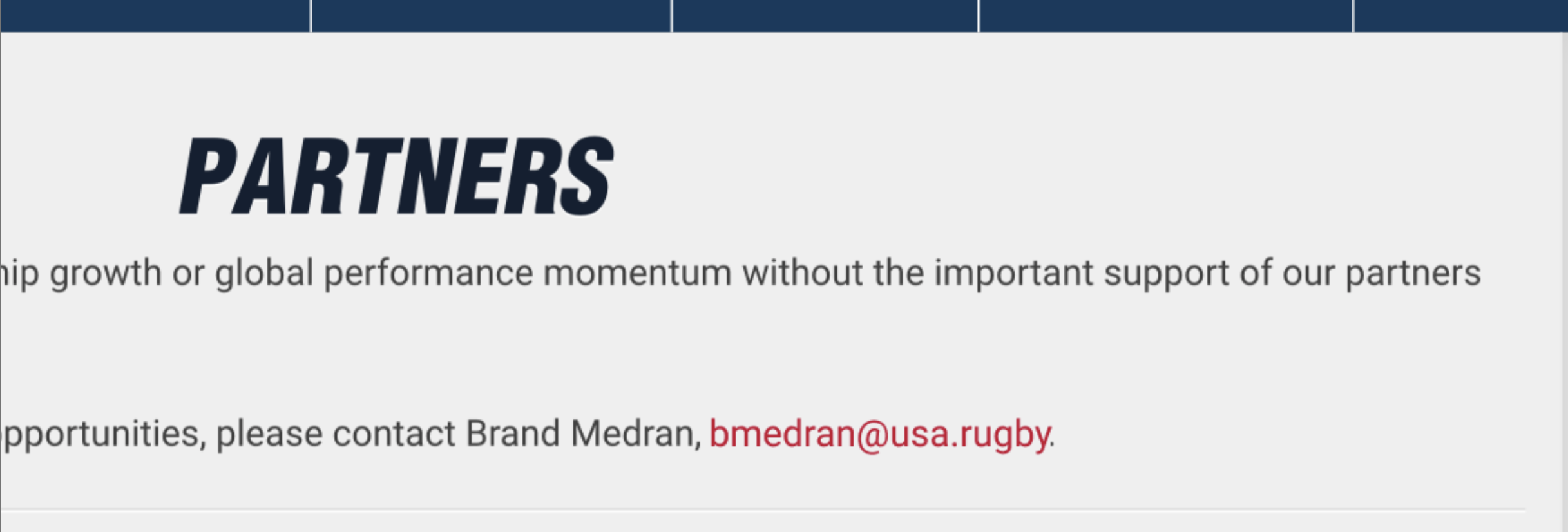Discovering opportunities to improve the browsing experience of USA Rugby’s Potential Financial Supporters
Overview
The USA Rugby website serves as the front door for rugby players, fans, and financial supporters to access rugby-related information and resources. Understanding the financial supporters' digital footprint is particularly helpful in achieving one of their important business goals: gaining commercial support and partnerships. Our team used Google Analytics and Hotjar heatmaps/session recordings to gather insights on this target audience. Unfortunately, data that's directly related to existing commercial partners and donors could not be collected due to the lack of event tracking and recent page traffic. Behaviors of “potential” financial supporters were instead identified from page visits and selected recordings.
My Role
UX Research
Data Analysis
Data Visulization
Presentation Design
Administrator & Editor
Tools
Google Analytics
Hotjar
Tableau
Figma
Google Optimize
Project Type
Advanced UX Research & Evaluation
Team
Olivia Turpin, Shih-Wen Huang, Wuke Zhou, & myself
Period
Jan 2022 - Mar 2022

The Problem
No inspection of financial supporters’ browsing behavior yet
USA Rugby has not yet analyzed their web analytics data by their different target audiences. Without knowing this, it is difficult to achieve the team’s goal of providing better insight on ways to ensure that potential financial supporters have a seamless experience with the USA Rugby website.
Research Questions to uncover the digital footprint of financial supporters
To solve the problem at hand, our team created 4 research questions to guide the research:

Analysis Process
Methodology: web analytics and click stream data to understand behaviors
Google Analytics was used to review data segmented by Potential Financial Supporters.
Since there was no event tracking set up before the research that would have helped identified users who filled out the donation form or contacted the organization to become a commercial partner, the team decided to segment users who visited the Philanthropy and/or Partners pages, calling them “Potential” Financial Supporters. The Philanthropy page was the entry page to access the donation form and the find information on ways to support the organization, while the Partners page listing information about sponsorships and partnerships. The team analyzed data from January 2015 (when the website launched) to February 2022 to gather as much data as possible.
Hotjar heatmaps and recordings were viewed to find recent browsing behaviors.
The heatmaps (visualizations of the users’ clicks, mouse movements, and scrolls) and the recordings were gathered from a 30 day time frame between February to March, 2022. Due to the limitation of hotjar not being able to capture all of the sessions, combined with the general low traffic to the financial support pages and possibility of our team skewing the data whenever we visit the website, only a few insightful data was collected from this tool.
Opportunities to Improve the user experience for Potential Financial Supporters
Analyzing the Google Analytics and Hotjar data, including visualizing it in charts and tables as needed in Tableau, helped the Team find 3 main findings that are worth addressing to improve the website’s user experience for the Potential Financial Supporters, who were found to be 0.2% of all the users.
Finding 1: Lack of strategic data tracking
1.1 It was impossible to accurately segment real financial supporters without event tracking set up.
It would have been ideal to track the activity of users who submitted a donation form or inquired about partnership and sponsorships, instead of only users who visited the Philanthropy and Partners pages. We can only assume that the users we were able to segment has an interest in financially supporting USA Rugby.
Google Analytics showing no event tracking set up.
Recommendations: Add event tracking & annotations in Google Analytics
Although donation form submission is the most accurate metric to identify real financial supporters, the donation form is an external page that Google Analytics cannot track. Therefore, event tracking for clicks to the donation form link can be added instead. It is also useful practice to annotate when tracking was set up or changes were made on the website on Google Analytics.
The contact email on the Partners page should be a hyperlink. Making any email, not just the inquiry email for partnerships/sponsorhips, into a hyperlink will allow it to be event tracked.
Example of hyperlinking the email on the Partners page.
Finding 2: Missed opportunities for certain device and browser
2.1 The Philanthropy pages were not optimized for mobile.
There were many usability issues found on the mobile version of the website, which is problematic since most of the visitors were found to be using mobile devices to view the website according to the Google Analytics data. The issues include:
Broken donation form link only on the mobile version of the site.
2. Repetition of the Philanthropy page’s sub sections in the movie hamburger menu.
There is a possibility that these issues were causing Potential Financial Supporters to use desktop devices more than mobile devices, which were favored by other users.
Device usage of potential financial supporters (left) vs. all users (right)
2.2 Content loaded slowly for Chrome browsers.
Since most Potential Financial Supporters were desktop users, the team decided to investigate the target audience’s most commonly used browser, Chrome.
Despite being a commonly used browser, Chrome was found to have a very slow average load time of 6.3 seconds for Potential Financial Supporters according to the Google Analytics data. A hotjar recording of a session on a chrome browser also exemplified this slow load time.
Hotjar recording of a session on a chrome browser showing a 4 second load time of the content.
Recommendation: Optimize for mobile and site speed
Fix the broken donation form page link so donations can be made from mobile devices.
Active donation page link on mobile.
Mobile dropdown menu with no duplicate submenu links.
2. Optimize for mobile view of Philanthropy subcategory pages.
3. Reduce unnecessary content, including resizing images to improve the load time on Chrome.
Finding 3: Lack of interest in & traffic to Philanthropy pages
3.1. There were few pageviews for the /philanthropy/ subpages.
While the Philanthropy parent page was the third most viewed page with about 2.7K pageviews, the sub section pages had almost no pageviews. This meant users usually did not navigate further into the section.
Pageviews of most viewed pages (top) vs the /philanthropy/ subpages (bottom).
3.2. Lack of interaction with philanthropy related links on the home page was found from Hotjar.
The heatmaps of users’ clicks showed very little interaction with the philanthropy related links from the home page, like the donate form button and link to the Philanthropy page in the menu. This indicated a missed opportunity to attract visitors to the Philanthropy pages from the homepage, the most popular landing page.
The home page’s heatmap of clicks not showing much interaction with the page link or donate button.
3.3. The Support/Donate label may be confused with a page to get general help.
There was a Hotjar session recording that showed mouse movements of a user who was looking at membership information and seemingly mistook “Support/Donate” as help support.
Recommendation: Redesign the Philanthropy section architecture
Change the page title and menu option name of the “Philanthropy” page to “Support Us” to give a clearer indication of what the page is about.

Redesign Proposal
Start with changing the home page
As the homepage is the most important gateway to other content in the website, the team suggested redesigning the homepage layout to make the Philanthropy related links stand out more to USA Rugby for their design initiative in 2022.
As recommended earlier, changing all titles for the Philanthropy pages to “Support Us” will better communicate the the type of content the page will offer.
Since there were no clicks on the donate icon recorded, the icon should be redesigned into a simple text button, which is more intuitive.
Changing the location of the other icons and search bar will help make the new Donate button stand out more.
The proposed homepage layout.
A simple A/B test before implementing bigger changes
It is important to test the change of the Support/Donate label first before making other changes, as it is the direct entrance to the Philanthropy page. Our team proposed conducting an A/B Test plan of this change, using Google Optimize to alter the label text. Setting up event tracking on the this call to action label will allow us to track the number of clicks on the label, and determine whether renaming the label to “Support Us” will attract potential financial supporters.
Variant of the homepage for the A/B Test Plan.
Conclusion
Positive Client response regarding label change
The team presented the research findings and suggestions to some of the key stakeholders at USA Rugby, who were happy for the opportunity to see the hotjar recording proving the confusion of the Support/Donate label because it was an element considered for redesign in the past. Before our team can implement the A/B test, USA Rugby have decided to implement a redesign of their own to change the label to “Donate”. When the test is implemented, performance differences between the “Donate” and “Support Us” label will be inspected.
Our team presenting to the client via Zoom.

Lessons Learned
Limitations in quantitative data were felt throughout this research. For example, although Hotjar is a helpful to gather many user behaviors anonymously, it prevented the team from uncovering the motivations behind each action. We could only assume or guess why the user was doing something on the page. Google Analytics also showed that Potential Financial Supporters used desktop devices more than all of the users, but our team could not specifically determine the reason why.
Next Steps
Our team plans to implement the A/B test with Google Optimize soon.
Setting up event tracking for the new label will hopefully be a start to adding more event tracking on other important call to action links, such as the link to the donation form, so that segmentation of actual Financial Supporters can be made.




















